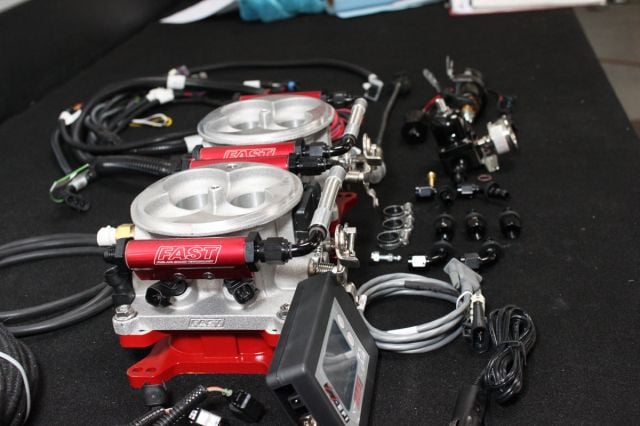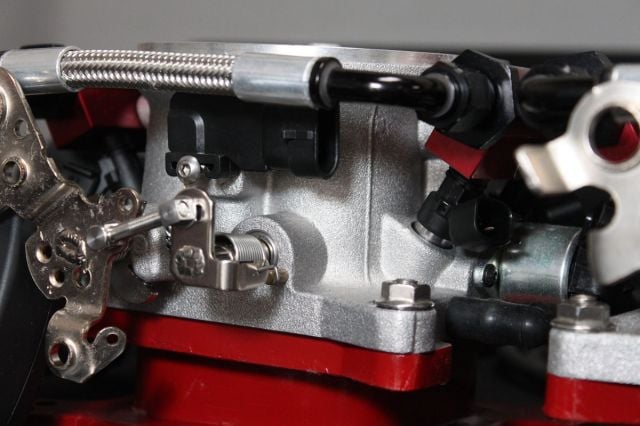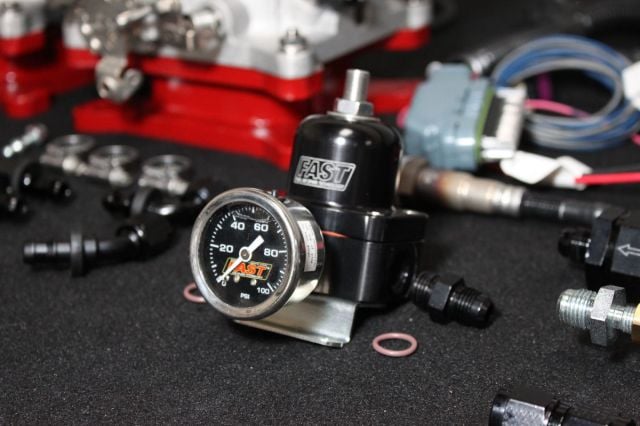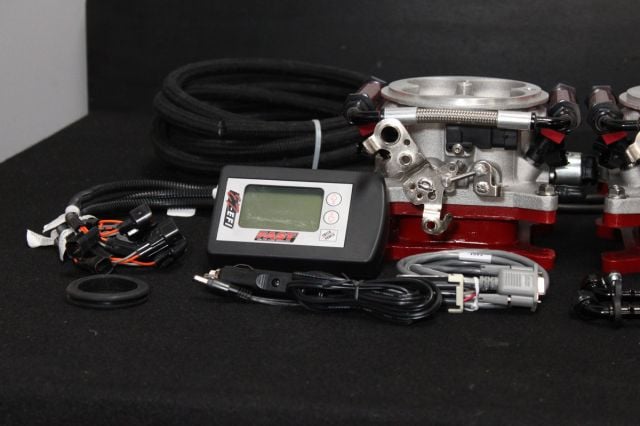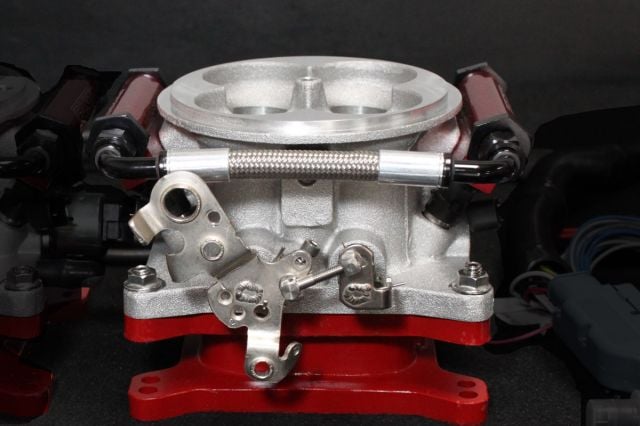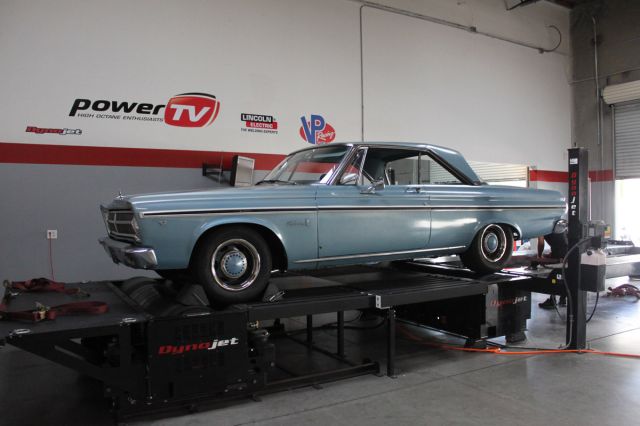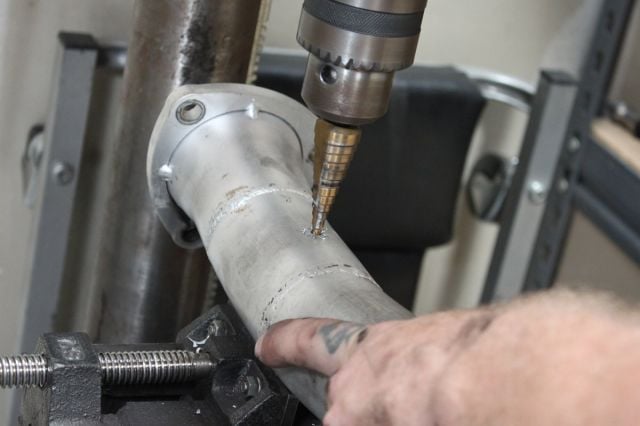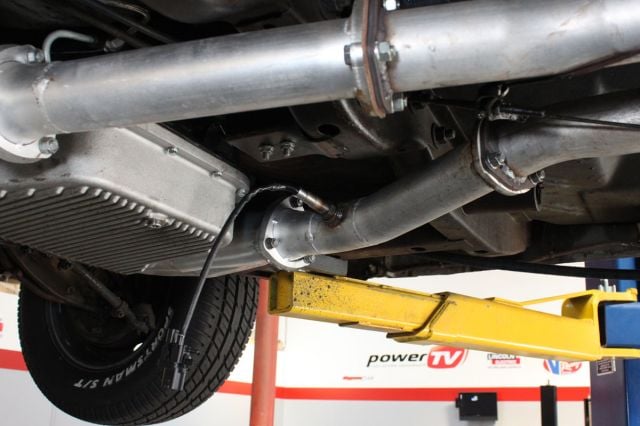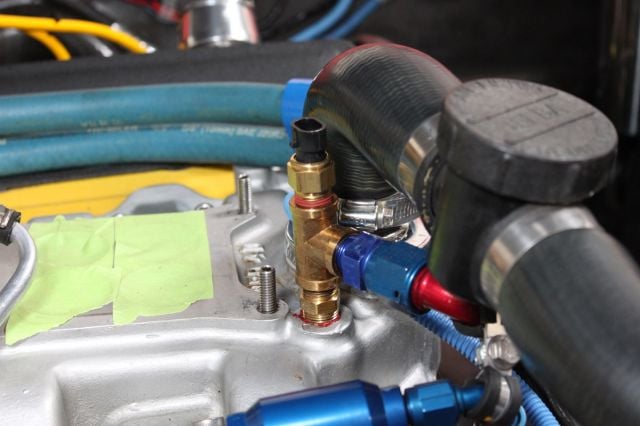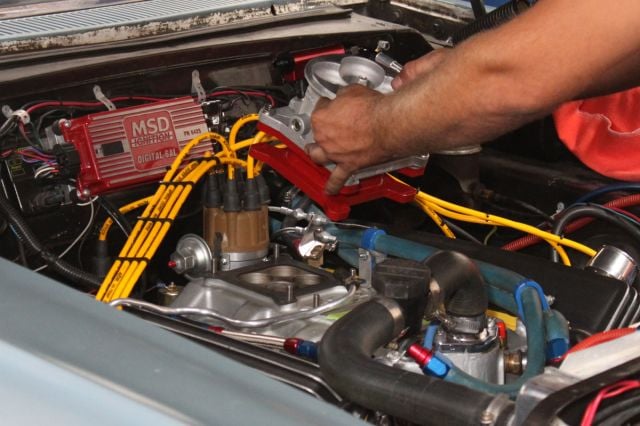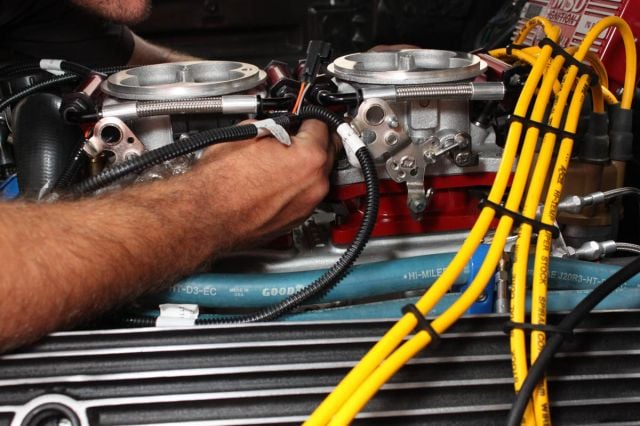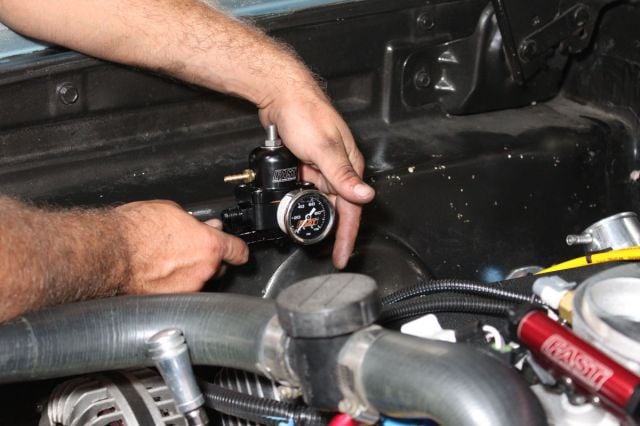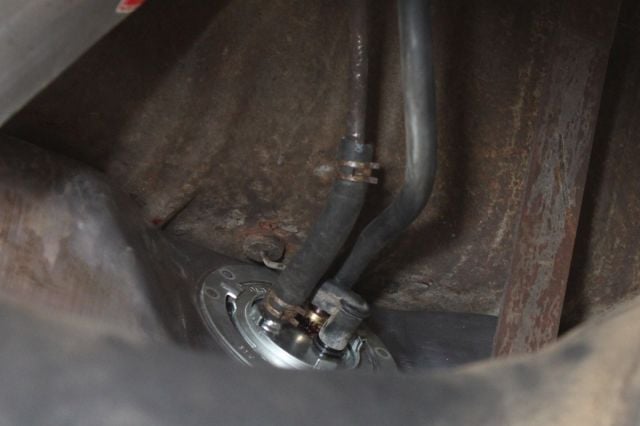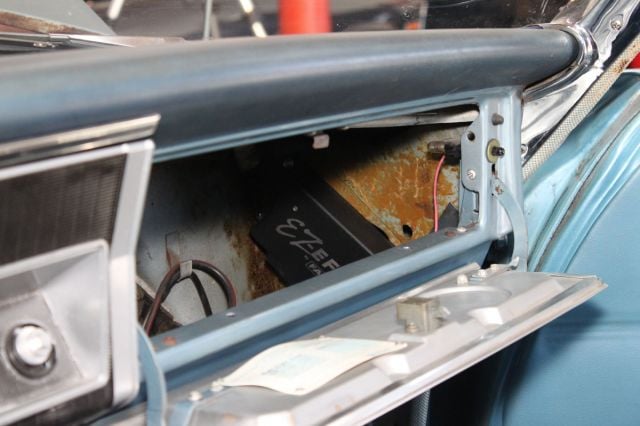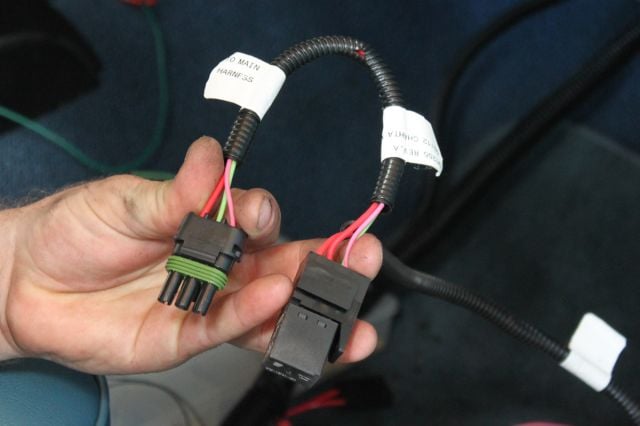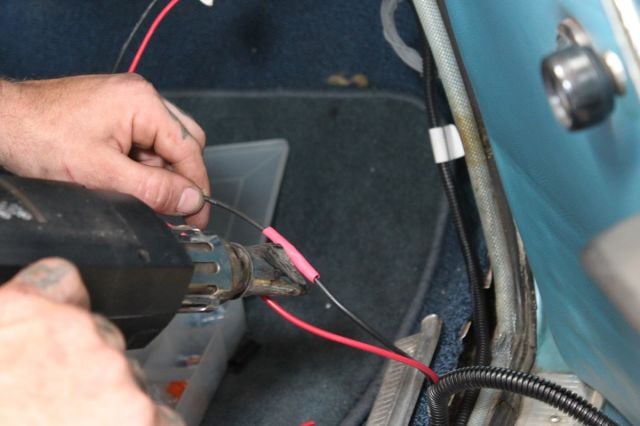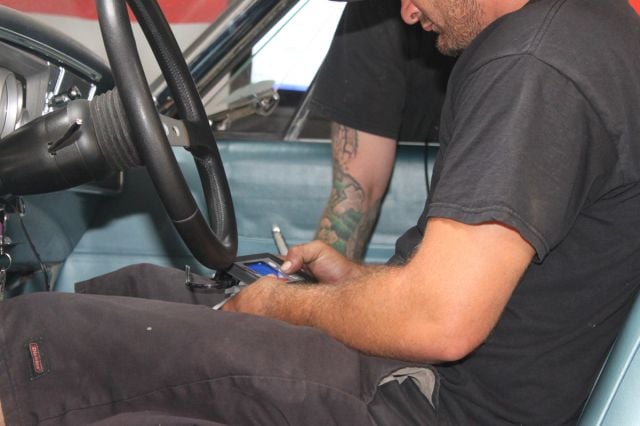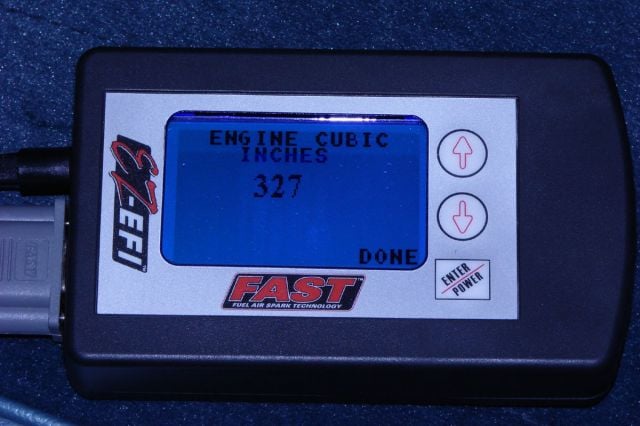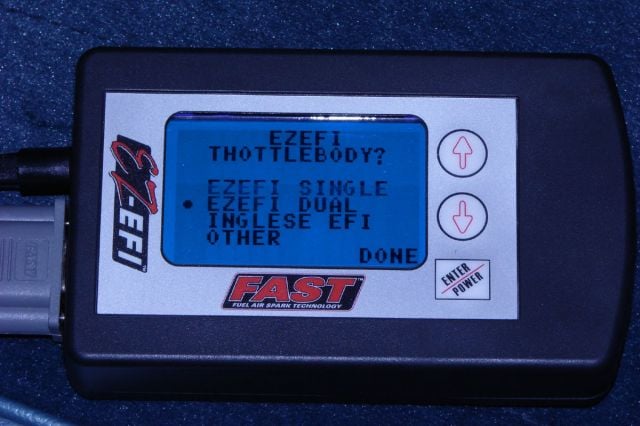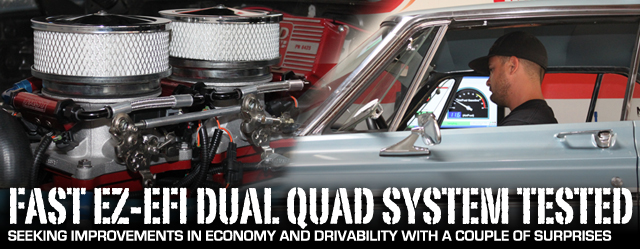 [1]There’s just something about seeing multiple carburetors on a V8 that makes people look a little closer. There’s also something about multiple carburetors that makes the owner work just a little harder on keeping the engine tuned properly. If one four-barrel carburetor isn’t hard enough to jet properly, imagine having to sync a pair of them and trying to keep your spark plugs from fouling at one end, and running too lean at the other.
[1]There’s just something about seeing multiple carburetors on a V8 that makes people look a little closer. There’s also something about multiple carburetors that makes the owner work just a little harder on keeping the engine tuned properly. If one four-barrel carburetor isn’t hard enough to jet properly, imagine having to sync a pair of them and trying to keep your spark plugs from fouling at one end, and running too lean at the other.
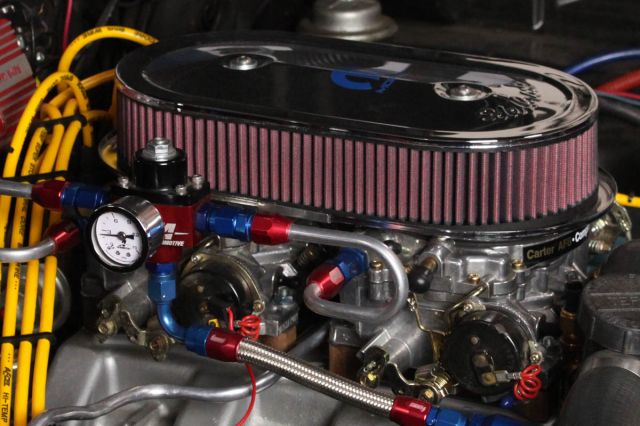 [2]
[2]Looks are deceiving with dual carbs: constant adjustments and poor jetting lessen the impact of good looks.
Then there’s the idle situation: it changes regularly, and you’re constantly trying to get the idle just right. A turn here and there, then the next time you drive your car and come to a stop light you look down at your tach and you’re idling at a grand.
It’s enough to make you rethink your multiple carburetors, let alone the fact that your fuel gauge will likely drop faster than you had thought. Still, most of us like the look of multiple carburetion on a V8 and we bite the bullet in exchange for the accolades and praises we get from it. We’re gluttons, and we realize it.
Dual Quad EFI
It almost doesn’t sound possible, but it’s true that you can now install a dual quad self-tuning EFI system on your dual quad intake or tunnel ram manifold thanks to Fuel Air Spark Technology [3], or FAST for short. Converting from carburetion to EFI isn’t exactly new to the automotive world. But what sets FAST apart from the others is that they have the industry’s only lifetime guarantee on their EFI system, and you can only get a self-tuning dual quad EFI system from FAST.
We installed a FAST EZ-EFI kit on a ’68 Camaro [4] a couple years ago, with the same 4150-style throttle body that is part of the dual quad kit. Our initial install on the Camaro took only one day to complete. The Master Kit includes injectors, all senders and sensors, the harness, fuel pump and regulator, the wideband O2, ECM and handheld control unit.
The EZ-EFI Dual Quad Kit form FAST includes the Master Kit, which is the same as a single EFI conversion kit, and the Add-On kit. Everything you need is included: senders and sensors, injectors, throttle bodies and harnesses, the wideband O2 sensor and a handheld control unit.
If you already have a single EZ-EFI installed and you want to upgrade your intake to dual quad, there’s no need to buy a complete new EFI kit, the add-on kit is all you will need to purchase. FAST states that the single EZ-EFI will support up to 650 horsepower, and the dual quad EZ-EFI will support up to 1200+ horsepower.
The dual quad EZ-EFI Add-On kit includes a spare throttle body with four fuel injectors, four add-on harnesses, a dual linkage kit and a fuel line crossover hose with fittings. The install process is the same as the single EZ-EFI, with the same connections to the ECM and using the handheld and setup wizard.
Connections are simple: you don’t need a laptop to program the ECM, and the only modification that you must add is a return line to your fuel tank. All the rest of the needed parts are in the Master Kit and the Dual Quad Add-On Kit.
The way the system works with a single or dual throttlebody is through the set up. With the add-on wiring harnesses and the setup function for Dual EZ-EFI, the injector pulse-width is cut in half; instead of four injectors doing the work, you have eight that split the duty.
The only sensors that must be installed are the coolant temperature sensor in the intake manifold, and the wide band O2 sensor in the exhaust. The remaining sensors and switches are mounted to the primary throttle body.
The volunteer: a 1965 Plymouth Belvedere II with dual quads.
Our project car is a 1965 Plymouth Belvedere II that is a fairly tame driver. It was never intended to be a show car, and never saw a dragstrip. The engine is a 318 Polysphere, with a mild build to it: .060 over pistons, a mild cam, porting work on the heads, a nice set of TTI headers, and the difficult-to-find aluminum dual quad manifold with a pair of Carter carburetors. While this engine was popular in the late 50’s through the mid 60’s, it was never a candidate for race teams, because of its weight and the lack of high performance parts.
We ran the car on our Dynojet prior to the install to get some base numbers, and of course the driving that’s been done on it in the past year was also noted. To give you an idea of where we started, the very first dyno that this car saw with a pair of 500 cfm carburetors was about 199 hp to the rear wheels. Not very impressive, to say the least. Despite the numerous adjustments and tweaking, there was something missing from this set up.
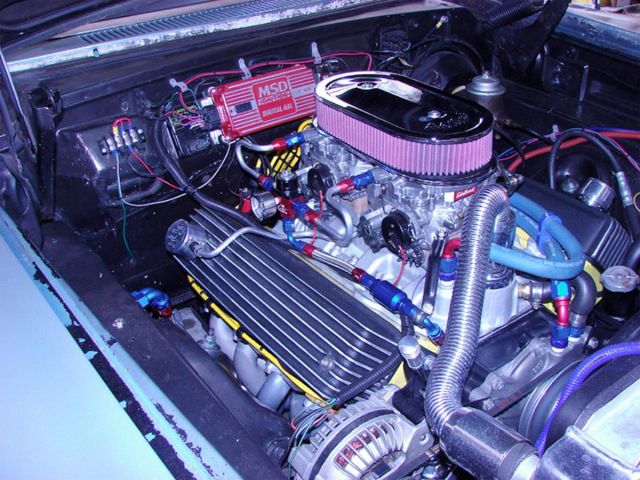 [11]
[11]A pair of 500 cfm carbs ran too rich at idle, a larger primary carb runs too lean at top end. Adjusting and tuning carburetors went on for months.
After swapping to a larger primary carburetor of 625 cfm, and a secondary carburetor with 525 cfm on a progressive linkage system, the drivability improved a little and we were able to get a couple more miles per gallon on long, freeway trips. But there was still something that was annoying about this set up: it looked great, but the throttle response was more like a weak suggestion with not much of a response. Stepping on the gas meant two things would happen: more fuel, and less than average acceleration.
More adjustments were made, and the idle mixtures were adjusted, but still we were only able to see 214.85 rwhp and 215.52 ft/lbs of torque on our Dynojet. This, for an engine that should see about 375 at the crank, meant that something was missing. We know that EFI is a little more efficient than carburetors, but with a car like this getting roughly 9-10 mpg, most people we talked to asked questions like “why?” and suggested that we don’t get our hopes up.
The intent here is to make this Belvedere more drivable, get better fuel mileage, and hopefully see much better throttle response out of it. It’s not likely that adding EFI will net you any large horsepower increase, as a matter of fact some companies will suggest that you may see a slight decrease in horsepower. We had some reasonable expectations for the dual quad EZ-EFI, and based on our prior install and others that we have seen with a single throttle body, the big question was: what kind of improvements will we see with two four-barrel throttle bodies?
Installation, Set Up and Initial Start
You must connect the power and ground wires directly to the battery. This can’t be ignored. -Kevin Winstead
As the description of the kit implies, the install is very “EZ”, and even with a classic car like this Plymouth the install took only a day in our shop. It can be done utilizing a lift like we did, but you should be able to knock this out in the driveway with a few well placed jack stands and by following the directions to the “T”.
We test fit everything prior to our planned installation, and that can save you lots of time. There’s nothing worse than starting an install and having to stop in the middle because of something that was overlooked. Just like the saying goes: measure twice and cut once.
Kevin Winstead, FAST’s in-house technician and EFI guru, says, “You must connect the power and ground wires directly to the battery. This can’t be ignored.” This means that you cannot connect them to your fuse block up under your dash, or to another circuit that connects to the battery. It’s very important that you have no EMI on the circuit, and that you don’t have another electrical component drawing power from the ECM.
Out with the old, in with the new. It's always a good idea to plan ahead on an installation like this on an older car with an older intake. Our intake had the small bolt pattern, and a pair of adapters were necessary to mount the 4150 style throttle bodies. The included wideband O2 sensor and mounting bung must be installed in the exhaust pipe after the exhaust header.
As for placement of the two throttle bodies, Winstead told us, “It doesn’t matter which unit is in front of the other. But you need to connect injector #1 on the main throttle body to injector #1 on the add-on throttle body, and likewise with the other three.” You will have to fasten the dual quad linkage and connect a crossover fuel line, but everything else connects and installs in the same manner as the single EZ-EFI kit.
“It’s best to put the control unit inside the car, but if you want to mount it in the engine compartment it will be fine, ” Winstead said. “You want to be sure that the LED is visible on the front of the control unit and that you don’t have it too close to heat or where water can get to it.” We asked about the fuel pump and it’s mounting location and Kevin said, “It has to be as close to the fuel tank as possible, and it has to sit below the tank. It really is best that you get the in-tank retro-fit pump to keep it cooler. It will last longer than the frame mounted pump, too.”
Once the installation was complete, we went through the set up wizard and answered the very simple questions: engine size, number of cylinders, idle rpm, etc., and followed the instructions on the hand held control unit to set up the ECM. With the dual quad, you must be sure to select Dual EFI from the handheld so the computer knows how to adjust the fuel rate properly.
As with any EFI system, the computer needs to know what the throttle position is (TPS), as well as the idle air control motor (IAC). The setup process will have you press the pedal to wide open throttle (WOT) and then to release it to take measurements. The next step afterwards is to start the car and let it idle, and to adjust idle speed to match what you programmed into the ECM with the handheld.
FAST strongly recommends a return type fuel system with their EZ-EFI. The pump is a non-bypass pump, and the included pressure regulator is designed to work with their set up. Finding a good place to mount the ECM makes the rest of the connections a breeze.
We checked for fuel leaks at all connections, crossed our fingers, and turned the key. The car started up almost immediately, and it held idle. We made the idle adjustments and monitored the engine’s functions, making sure that we didn’t miss anything. Everything seemed to be working just fine and we could see from the handheld that the computer was going into its “adaptive learning” cycle from the readings that the wideband O2 sensor was sending to the ECM.
There might be temptations to play around with some of the other settings, but the best thing to do is to initially set it up to run, and only making other adjustments when you’ve learned to use the system properly. While you don’t need to have programming skills, nor do you need a laptop computer, it doesn’t mean that there aren’t adjustments that will need to be made. It’s how these adjustments are made that makes this installation simple. The computer does all the calculating, but you have to feed it the right information to begin with.
Everything was functioning so well that it almost seemed too easy, but was that going to be enough to sell us on this dual quad EZ-EFI? Of course not, we wanted to see more than an easy starting classic car with a smoother idle; we needed to see some results, so off the car went for two weeks to drive, take it to shows, hit the throttle and put this EZ-EFI system through its paces. We wanted results, and the results were surprising.
The setup wizard runs you through a series of questions: displacement, number of cylinders, etc., and a few selections from multiple choice type answers. No laptops, just the handheld unit.
Surprises On And Off The Dyno
After a few cruises to the local parts stores, fast food joints and a couple of local cruise spots, the next plan was a long trip to San Diego to visit the Mopar Club of San Diego. We visited with old friends and saw what they’ve done to their cars over the years, and of course to show off the new EFI system. With a careful eye on the tach and the fuel gauge, it was so tempting to mash the go-stick and see what the performance was like, but the purpose of the long, 140 mile round trip was to see what kind of fuel economy the Plymouth could get
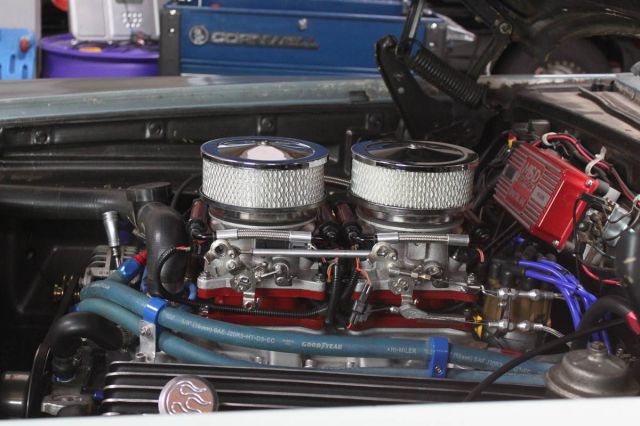 [26]
[26]At first glance, it’s a typical dual quad, but a closer look reveals some wiring harnesses and sensors. Then the fuel rails pop out at you and you realize something is different.
Most people were shocked to see two 4150-style throttle bodies on a 1965 Plymouth, and a couple of onlookers asked, “What kind of carbs are those?”
“Dual quad e-eff-eye??? What’s that?” was one of the questions from an onlooker. He’d never seen or heard of such an animal. With some explanations and pointing to fuel rails, fuel injectors and all the sensors on the main throttle body, some responses changed from “huh?” to “holy cow!”
We chatted for a while, grabbed a bite to eat, and parted company as the remaining 70 miles needed to be logged and accounted for. The return trip, admittedly, saw a little more throttle play than the first leg, but it was kept to a minimum because we wanted you to see the real results of a normal cruise, on a normal weekend or evening. The results were pretty impressive.
Filling the fuel tank with 140.3 miles on the odometer, the gas pump registered 10.013 gallons. This meant that the Plymouth got a whopping 14 MPG, good for about a 4 MPG improvement by upgrading to an EZ-EFI system.
With the tank filled up again, it was time for playing around: stop light to stop light, hard launches, high speed passes, uphill climbs and showing off. Remember when we said the throttle response was more like a weak suggestion? Not any more. Another great feature is that we can program the ECM to deliver a little more fuel when we first romp on the throttle without affecting the rest of the settings. That means we sort of have an electronically controlled “accelerator pump” with our EFI.
Throttle response is immediate now, and when we want to pass someone, even on a hill, it happens much quicker. There were a few times when the throttle response was so immediate that it caught us off guard – we weren’t used to seeing this kind of response. The car runs great, and it runs so smooth that it almost feels like the suspension has been upgraded because it no longer runs rough.
On The Dyno
Starting in the morning is a breeze, no playing with the throttle, the choke, or worrying about flooding. The pre-squirt feature squirts enough fuel to start the engine, and the idle is immediate. Even a neighbor mentioned that he knew the EZ-EFI was installed because he could tell that the car sounded “better”.
But now for the part the kind of blew us all away: the dyno results. We had an initial run of 214.85 rwhp with 215.52 ft/lbs of torque, with a pretty lean and choppy AFR of about 14.5:1. That’s not very good, and the choppiness on the dyno graph shows that it was probably going through a little detonation.
The last run on the dyno after the installation was impressive. While we want to state explicitly that there are no guarantees and this is not a typical result, it is the most impressive part of this installation. We started with poor numbers with dual carburetors; the Dual Quad EZ-EFI system saw a very impressive increase of 19.95 rwhp, for a net of 234.60 rwhp. There was an increase in torque of 20.98 ft/lbs to 236.50, and the AFR dropped to where it should be running – at about the 12.5:1 range instead of the previous 14.5:1 range.
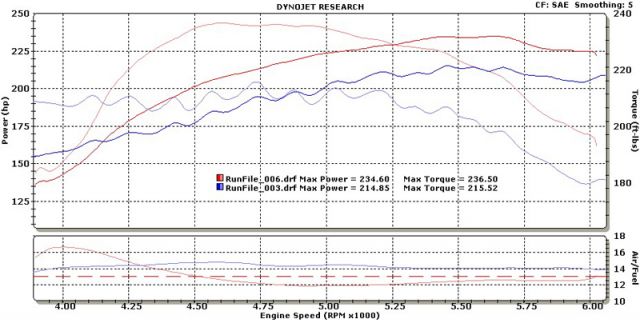 [27]
[27]We achieved 234.6 rwhp and 236.5 ft/lbs of torque. An increase in 19.95 rwhp and 20.98 ft/lbs was achieved after removing a pair of Carter Carburetors and installing the FAST Dual Quad EZ-EFI system.
The handheld for this EZ-EFI system is very easy to use, and allows you to monitor the functions that are critical to this system. As mentioned, you can add a little fuel for better throttle response, and you can set your target air/fuel ratios for idle, cruise and wide open throttle (WOT). The WOT target is not only at 100% WOT, it’s a gradual measure that begins to take place at about 50% throttle and increases progressively until WOT is achieved. This allows you to set your cruise AFR a little lean for economy, without worry of what will happen when you’re at 75% throttle.
Conclusions
For the past year, driving the Plymouth has been fun, but it hasn’t been what was expected: cold starting problems, hot starting problems, fiddling with the carburetors, fiddling with the linkage and constantly making adjustments. The fuel gauge dropping rapidly was somewhat expected, but it wasn’t entirely acceptable and with the price of gas the car spent fewer hours on the road in lieu of a more economic mode of transportation. Car shows and cruises were about all this car got to see, and long trips were infrequent.
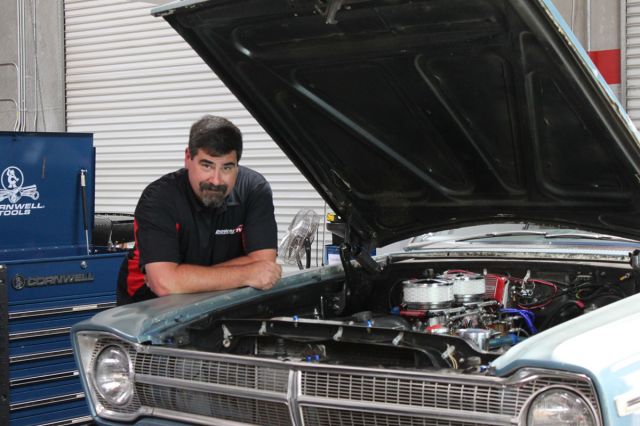 [28]
[28]The car is now much more fun to drive, and the throttle response is far better than it ever was with a carburetor or two.
We went into this not knowing how well a dual quad EFI system would work, or if it would return results that were going to make it all worth it. We knew that the single EZ-EFI system was a solid unit and that it produced some decent results, and overall it was the drivability that we were after with this install. We didn’t expect much at all by way of horsepower increases, but we did expect to see the car run much better, and that it did.
Seeing a jump in fuel mileage was impressive. The better AFR and how well the engine ran were equally impressive. The increase in horsepower was a surprise, and it showed us two things about the carburetors: the car was never running properly before, and the lean AFR limited the performance more than we had thought. Twenty more horsepower proves it, and while it’s not common to see such an increase it is one that deserves some bragging rights. EFI may not increase horsepower, but a well tuned engine will give you better performance and economy – and that is something we achieved with the FAST EZ-EFI Dual Quad system.
